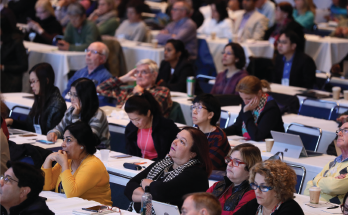 CHICAGO—Held during the 2018 ACR/ARHP Annual Meeting, the ACR Review Course covered a wide range of topics for rheumatologists—from advances in pain and rheumatic disease management to the intersection of rheumatology and neurology. Session speakers shared insights, as well as state-of-the-art approaches to diagnosis, management and treatment.
CHICAGO—Held during the 2018 ACR/ARHP Annual Meeting, the ACR Review Course covered a wide range of topics for rheumatologists—from advances in pain and rheumatic disease management to the intersection of rheumatology and neurology. Session speakers shared insights, as well as state-of-the-art approaches to diagnosis, management and treatment.
Inflammatory Myopathies
Julie J. Paik, MD, MHS, assistant professor of medicine at the Johns Hopkins University School of Medicine, Baltimore, updated the audience on idiopathic inflammatory myopathies, also known as myositis. She began by reviewing the four main types of idiopathic inflammatory myopathies: dermatomyositis, polymyositis, immune-mediated necrotizing myopathy and inclusion body myositis.
Dr. Paik then presented the 2017 EULAR/ACR Classification Criteria for Adult and Juvenile IIM and Their Major Subgroups.1 These criteria represent the first update since the original 1975 classification criteria, which were limited because, although they were sensitive, they were not specific.2 Dr. Paik noted these criteria were old and said, “it was time to move on.”
The process of creating new criteria began in 2004 and included 47 rheumatology, dermatology, neurology and pediatric clinics worldwide. Experts from these clinics reviewed data from 976 idiopathic inflammatory myopathy patients and 624 non-idiopathic inflammatory myopathy patients who had mimicking conditions. The criteria are intended to aid clinicians in distinguishing myositis from myositis mimickers.
Sixteen variables are included the final 2017 EULAR/ACR classification criteria. The criteria note the age of onset is important for distinguishing juvenile from adult cases. They detail the importance of muscle biopsy features, such as endomysial infiltration, perimysial and/or pervascular inflammation, perifasicular atrophy and rimmed vacuoles. And they include a discussion of the anti-Jo-1 antibody, which was the only myositis-specific autoantibody readily available in 2004. Dr. Paik highlighted an online calculator that can be used to input all criteria and determine the probability of myositis.
Dr. Paik then described three challenging myositis cases. The first was a description of transcription intermediary factor-1 gamma-positive dermatomyositis. Although these patients have severe skin disease, they are less likely to have interstitial lung disease (ILD), Raynaud’s or arthritis. Unfortunately, they are at an increased risk of cancer. Their disease tends to be refractory, and they should receive age-appropriate malignancy screening. Dr. Paik also reviewed several ongoing clinical trials in dermatomyositis that show promise, and she highlighted the potential of lenabasum as a successful therapy for these patients.
Knee replacement rates in SLE patients have increased sixfold from 1991–2005. This dramatic increase likely reflects the increased health & survivorship of this patient population.
For the second case, Dr. Paik presented the case of a patient with anti-synthetase syndrome (ASyS) with prominent ILD. Experts now recognize ASyS as a distinct form of myositis, she said, noting that these patients often first present with arthritis. Dr. Paik emphasized the importance of keeping ASyS in the differential when a new patient is evaluated for inflammatory arthritis. ASyS patients commonly progress from inflammatory arthritis to the more recognized triad of myositis, polyarthritis and ILD. Treatment should be directed at the most active organ manifestation.
Last, Dr. Paik discussed inclusion body myositis, noting the gold standard for the diagnosis is the presence of rimmed vacuoles on muscle biopsy associated with the appropriate pattern of muscle weakness. She highlighted the importance of testing for finger flexor weakness and described a newly discovered autoantibody, NT5C1-A, which is commercially available and positive in up to 60% of patients with inclusion body myositis. She also explained that immunosuppression does not work for these patients and may even be harmful.


